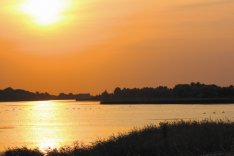 The historic buildings merged into the modern, sky-reaching Warsaw. The academic area surrounded with a huge agricultural terrain. We are inviting you to Mazovia - the region of contracts and big opportunities.
The historic buildings merged into the modern, sky-reaching Warsaw. The academic area surrounded with a huge agricultural terrain. We are inviting you to Mazovia - the region of contracts and big opportunities.
We suggest to begin our excursion from Płock, the oldest town in the region. Płock is located in the middle of Mazovia, at the borderland of Kotlina Płocka and Pojezierze Dobrzyńskie.
The burg city, established on the slope above the Vistula River, used to be the seat of bishops, Mazovian dukes and Polish lords. It is an amazing place and as such – it has been the inspiration for poets, painters and cameramen. Its magic is hidden in its unique beauty created by the history and the present.
In Pułtusk, only 60 kilometers away from Warsaw, inside the walls of the XVth c. Castle located on the brink of Puszcza Biała, at the blue Narew- there is the Polonia House (now a beautiful hotel). The city is famous for the longest (380 kilometers) cobbled square in Europe.
Żelazowa Wola is a small town located in the Mazovian plateau, on the outskirts of Sochaczew. There is a beautiful manor – the place where the world famous pianist and composer, Frederic Chopin, was born. The interior of the museum reflects the character of the epoch; however, the Chopins’ manor XIXth c. equipment has not survived till today.
The precincts of Grójec are the biggest fruit growing areas in Poland. They call this place the biggest orchard in Europe, and it is said that every third apple in Poland is grown Grójec. These apples are of unusual acidity and beautiful red color - the features ensured by the unique microclimate of the area.
The Zegrze Reservoir [Zalew Zegrzyński] is a place for recreation for Warsaw and neighboring citizens due to the many guest houses and water sport facilities located mainly in Zegrz, Zegrzynek, Białobrzegi and Rynia. Around the water reservoir there are cycling paths.
Near Warsaw there is the Kampinos Forest [Puszcza Kampinoska] – the Kampinos Enlarge
National Park [Kampinowski Park Narodowy] one of the most important forest complexes in Poland. In the forest growing on the sand dunes there live such wild animals as elks, lynxes, beavers and badgers.
The Bug Landscape Park [Nadbużański Park Narodowy], located in central-eastern part of the Mazowieckie Province, is characterized by the variety of landscape yet its most important value is the Bug valley, with many oxbow lakes and islands in the current and sandbanks and slopes. Circa 1/3 of the park’s area is covered by forests - the remains of the old virgin forests. Other interesting places are the ruins of the old castles of Mazovian dukes in Ciechanów and Czersk, the stronghold in Modlin, the river basin of Narew or Konstancin Jeziorna - the beautiful health resort near Warsaw.
The Mazovian Lanscape consists of heights and plains, crossed out by the wide valleys of the queen of the Polish rivers – the Vistula, the symbolic Bug river, the historic Bzura river, and picturesque rivers: Narew, Pilica and Wkra.
There are only a few, mainly post-glacial lakes, like the one near Gostynin and the lakes in the Pojezierze Dobrzynskie. The forests cover more than 20% of the area, where the green pines and long-lasting oaks predominate the landscape.